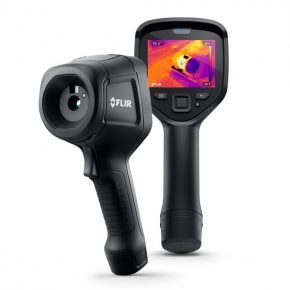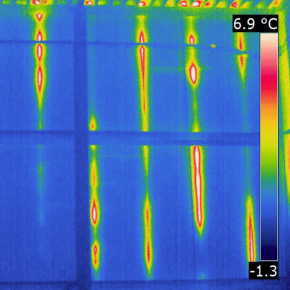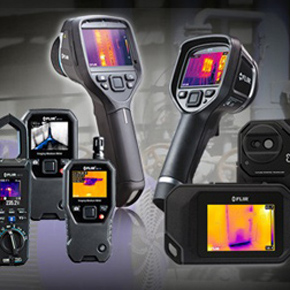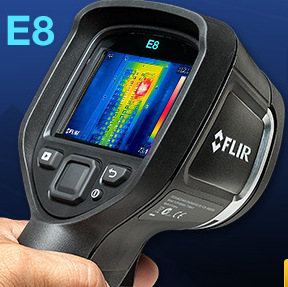More articles
28 Mar 2025
FLIR, a Teledyne Technologies company, introduces the Si1-LD, an industrial acoustic imaging camera that brings faster and more accurate compressed air leak detection to those operating on a modest condition monitoring budget.
Posted in Acoustics, Noise & Vibration Control, Articles, Building Industry News, Building Products & Structures, Building Services, Facility Management & Building Services, Information Technology, Innovations & New Products, Retrofit & Renovation, Sustainability & Energy Efficiency, Thermal Imaging and Monitors
24 Mar 2025
This interesting article from FLIR explores how thermal imaging can be used for hydrogen flame detection and monitoring…
Posted in Articles, Building Industry News, Building Products & Structures, Building Services, Facility Management & Building Services, Information Technology, Posts, Restoration & Refurbishment, Retrofit & Renovation, Sustainability & Energy Efficiency, Thermal Imaging and Monitors

24 Feb 2025
Data centre maintenance teams have a big share in safeguarding the critical resource that customers and businesses depend upon. Fortunately, they have one secret weapon that enables them to spot issues in an early stage before they turn into big problems – FLIR thermal imaging.
Posted in Articles, Building Industry News, Building Products & Structures, Building Services, Facility Management & Building Services, Information Technology, Innovations & New Products, Posts, Research & Materials Testing, Retrofit & Renovation, Sustainability & Energy Efficiency, Thermal Imaging and Monitors
18 Oct 2024
Frequent downtime can damage equipment, reducing its potential lifespan and increasing maintenance costs. FLIR has more…
Posted in Articles, Building Industry News, Building Products & Structures, Building Services, Information Technology, Research & Materials Testing, Retrofit & Renovation, Sustainability & Energy Efficiency, Thermal Imaging and Monitors, Walls

11 Oct 2024
The Lowdown on Identifying Air and Gas Leaks – this informative article comes from Darrell Taylor, from thermal imaging specialists FLIR…
Posted in Acoustics, Noise & Vibration Control, Articles, Building Industry News, Building Products & Structures, Building Services, Facility Management & Building Services, Health & Safety, Heating Systems, Controls and Management, Heating, Ventilation and Air Conditioning - HVAC, Information Technology, Innovations & New Products, Pipes, Pipes & Fittings, Plumbing, Posts, Research & Materials Testing, Restoration & Refurbishment, Retrofit & Renovation, Sustainability & Energy Efficiency, Thermal Imaging and Monitors

13 Sep 2024
FLIR is building more than innovative technologies – the company is striving to build a more sustainable, more efficient, safer future.
Posted in Articles, Building Industry News, Building Products & Structures, Building Services, Facility Management & Building Services, Health & Safety, Heating Systems, Controls and Management, Heating, Ventilation and Air Conditioning - HVAC, Information Technology, Innovations & New Products, Retrofit & Renovation, Sustainability & Energy Efficiency, Thermal Imaging and Monitors, Walls

19 Mar 2024
The Greening Campaign, founded by Terena Plowright, has set its sights on an ambitious goal – to make the entire United Kingdom greener, one community at a time. This initiative seeks to address a pressing concern regarding the widespread lack of awareness about the importance of energy efficiency within homes. FLIR’s C5 cameras are being used there…
Posted in Articles, Building Associations & Institutes, Building Industry News, Building Products & Structures, Building Services, Case Studies, Facility Management & Building Services, Heating Systems, Controls and Management, Heating, Ventilation and Air Conditioning - HVAC, Information Technology, Posts, Retrofit & Renovation, Sustainability & Energy Efficiency, Thermal Imaging and Monitors

6 Nov 2023
Teledyne FLIR, part of Teledyne Technologies Incorporated, introduces a new 80° lens with an ultra wide field of view.
Posted in Articles, Building Industry News, Building Products & Structures, Building Services, Facility Management & Building Services, Information Technology, Innovations & New Products, Sustainability & Energy Efficiency, Thermal Imaging and Monitors
13 Oct 2023
This informative article sees thermal imaging specialist FLIR outline why it is imperative that thermographers receive sufficient training…
Posted in Articles, Building Industry Events, Building Industry News, Building Products & Structures, Building Services, Facility Management & Building Services, Information Technology, Posts, Retrofit & Renovation, Site Preparation, Sustainability & Energy Efficiency, Thermal Imaging and Monitors, Training
22 Sep 2023
Teledyne FLIR, part of Teledyne Technologies Incorporated, introduces the FLIR ONE Edge, the wireless dual thermal and visible camera system for mobile devices.
Posted in Articles, Building Industry News, Building Products & Structures, Building Services, Facility Management & Building Services, Heating Systems, Controls and Management, Information Technology, Innovations & New Products, Thermal Imaging and Monitors
19 Sep 2023
Teledyne FLIR, part of Teledyne Technologies Incorporated, launches the focus free FLIR E5 Pro and FLIR E6 Pro cameras, providing a larger 3.5-inch touchscreen display.
Posted in Articles, Building Industry News, Building Products & Structures, Building Services, Facility Management & Building Services, Information Technology, Innovations & New Products, Site Preparation, Sustainability & Energy Efficiency, Thermal Imaging and Monitors
19 Jul 2023
Teledyne FLIR’s continuous strive for innovation has led to the creation of two new state-of-the-art spot IR thermometers – the FLIR TG54-2 and FLIR TG56-2.
Posted in Articles, Building Industry News, Building Products & Structures, Building Services, Facility Management & Building Services, Information Technology, Innovations & New Products, Thermal Imaging and Monitors
30 May 2023
Teledyne FLIR, part of Teledyne Technologies Incorporated, announces the launch of the DM286 Infrared Guided Measurement (IGM™) Multimeter, and two new clamp meters, the CM57-2 and the CM85-2.
Posted in Articles, Building Industry News, Building Products & Structures, Building Services, Facility Management & Building Services, Information Technology, Innovations & New Products, Sustainability & Energy Efficiency, Thermal Imaging and Monitors
24 Mar 2023
Designed for remodelling, restoration, inspection, and claims professionals, the magicplan app (from Teledyne FLIR) makes invasive manual property inspections a thing of the past.
Posted in Articles, Building Industry News, Building Products & Structures, Building Services, Damp & Waterproofing, Facility Management & Building Services, Heating Systems, Controls and Management, Heating, Ventilation and Air Conditioning - HVAC, Information Technology, Innovations & New Products, Thermal Imaging and Monitors

24 Feb 2023
Teledyne FLIR announces its newest and most powerful Extech videoscope series, the Extech HDV700.
Posted in Air Conditioning, Articles, Building Industry News, Building Products & Structures, Building Services, Drainage, Facility Management & Building Services, Heating Systems, Controls and Management, Heating, Ventilation and Air Conditioning - HVAC, Information Technology, Innovations & New Products, Pipes, Pipes & Fittings, Plumbing, Site Preparation, Thermal Imaging and Monitors

15 Nov 2022
Teledyne FLIR is hosting a free webinar to discuss how to prevent energy losses and combat rising energy costs with thermal imaging cameras on the 24 November 2022 at 1pm.
Posted in Articles, BIM, Infrastructure & CAD Software, Building Industry Events, Building Industry News, Building Products & Structures, Building Services, Damp & Waterproofing, Facility Management & Building Services, Heating Systems, Controls and Management, Heating, Ventilation and Air Conditioning - HVAC, Information Technology, Seminars, Site Preparation, Sustainability & Energy Efficiency

14 Nov 2022
Teledyne FLIR, part of Teledyne Technologies Incorporated, has announced the launch of its FLIR ONE® Edge Pro, a wireless thermal-visible camera for mobile devices.
Posted in Articles, Building Industry News, Building Products & Structures, Building Services, Facility Management & Building Services, Health & Safety, Information Technology, Innovations & New Products, Sustainability & Energy Efficiency, Thermal Imaging and Monitors
11 Nov 2022
Detect hidden sources of heat and energy loss with Teledyne FLIR’s thermal imaging cameras to save energy and cut your heating and energy costs.
Posted in Articles, Building Industry News, Building Products & Structures, Building Services, Damp & Waterproofing, Facility Management & Building Services, Health & Safety, Heating Systems, Controls and Management, Heating, Ventilation and Air Conditioning - HVAC, Information Technology, Posts, Site Preparation, Sustainability & Energy Efficiency, Thermal Imaging and Monitors
26 May 2020
FLIR Systems, Inc. has launched the FLIR C5 Compact Thermal Camera with new built-in FLIR Ignite™ cloud connectivity and Wi-Fi features for professionals in the building maintenance, manufacturing, and utility industries.
Posted in Articles, Building Industry News, Information Technology, Innovations & New Products, Site Preparation, Thermal Imaging and Monitors
24 Jan 2020
FLIR Systems has found the average UK home wastes £363 worth of heat through poor insulation, with nearly half of consumers citing winter energy bills as a major concern.
Posted in Articles, Building Industry News, Building Services, Information Technology, Posts, Sustainability & Energy Efficiency, Thermal Imaging and Monitors
23 Aug 2019
Gubba Cold Storage has invested in FLIR thermal imaging to prevent any insulation failures or electrical faults compromising temperature regulation.
Posted in Articles, Building Industry News, Building Regulations & Accreditations, Building Services, Case Studies, Information Technology, Insulation, Posts, Thermal Imaging and Monitors
1 Jul 2019
Commercial walk-in freezers use a lot of energy, so it is imperative that this consumption is kept to a minimum, which FLIR can help with.
Posted in Articles, Building Industry News, Information Technology, Posts, Sustainability & Energy Efficiency, Thermal Imaging and Monitors
14 May 2019
FLIR Systems introduces FLIR Thermal Studio, a thermal image analysis and reporting software designed to manage large sets of thermal images and videos.
Posted in Articles, Building Industry News, Information Technology, Innovations & New Products, Posts, Thermal Imaging and Monitors
12 Apr 2019
FLIR Systems has announced the new FLIR VP42, a non-contact voltage detector with a built-in flashlight.
Posted in Articles, Building Industry News, Information Technology, Innovations & New Products, Posts, Thermal Imaging and Monitors
4 Apr 2019
FLIR Systems has announced the addition of several webinars to its ITC training programme 2019 at its Infrared Training Centre (ITC).
Posted in Articles, Building Industry Events, Building Industry News, Information Technology, Thermal Imaging and Monitors, Training
22 Mar 2019
To be fully effective, climate control ceiling elements must be properly installed and this is where the diagnostic ability of FLIR thermal imaging is essential
Posted in Articles, Building Industry News, Building Products & Structures, Ceilings, Information Technology, Posts, Research & Materials Testing, Sustainability & Energy Efficiency, Thermal Imaging and Monitors
12 Mar 2019
At Futurebuild 2019, which took place last week, FLIR launched the T840, a new thermal camera in the high-performance T-Series family
Posted in Articles, Building Industry Events, Building Industry News, Exhibitions and Conferences, Information Technology, Innovations & New Products, Posts, Thermal Imaging and Monitors
20 Feb 2019
FLIR Systems has launched the FLIR T840, a new thermal camera in the high-performance T-Series family, which offers a brighter display and an integrated viewfinder.
Posted in Articles, Building Industry News, Information Technology, Innovations & New Products, Thermal Imaging and Monitors
10 Aug 2018
FLIR Systems has announced the launch of the FLIR ONE® Pro LT, a new lower price point thermal imaging attachment for smartphones in the FLIR ONE Pro series.
Posted in Articles, Building Industry News, Information Technology, Thermal Imaging and Monitors
1 Aug 2018
The growth in demand for FLIR’s expertise in minimising energy loss has resulted in a new wave of investment.
Posted in Articles, Building Industry News, Information Technology, Innovations & New Products, Posts, Research & Materials Testing, Thermal Imaging and Monitors
26 Jul 2018
FLIR Systems has launched the FLIR ONE® Pro LT, a new lower price thermal imaging attachment for smartphones in the FLIR ONE Pro series.
Posted in Articles, Building Industry News, Information Technology, Innovations & New Products, Posts, Thermal Imaging and Monitors
17 May 2018
FLIR ITC, an accredited authorised training organisation for the British Institute of Non-Destructive Testing, has released dates and venues for its Category 1 and 2 thermography courses.
Posted in Articles, Building Industry Events, Building Industry News, Information Technology, Posts, Thermal Imaging and Monitors, Training
19 Mar 2018
FLIR Systems has released the FLIR intelliRock™ III, the first concrete strength and temperature profiling system which features a built-in thermal imager.
Posted in Articles, Building Industry News, Concrete, Cement, Admixtures, Information Technology, Innovations & New Products, Posts, Site Preparation, Thermal Imaging and Monitors
13 Mar 2018
Buildingtalk Online Editor Max Banner reported on FLIR’s offerings at this year’s Ecobuild show, which included the launch of their E53. Check out the video and picture content below.
Posted in Articles, Building Industry Events, Building Industry News, Exhibitions and Conferences, Information Technology, Innovations & New Products, Posts, Thermal Imaging and Monitors, Videos
23 Feb 2018
FLIR Systems’ E53 becomes the newest member of the Exx-Series of advanced thermal imaging cameras for electrical, mechanical, and building applications.
Posted in Articles, Building Industry News, Information Technology, Innovations & New Products, Posts, Thermal Imaging and Monitors
14 Dec 2017
For an industrial inspection, troubleshooting and diagnostic tool, look no further than FLIR’s latest product, the DM285 thermal imaging digital multimeter.
Posted in Articles, Building Industry News, Heating, Ventilation and Air Conditioning - HVAC, Information Technology, Innovations & New Products, Posts, Thermal Imaging and Monitors
14 Dec 2017
Ecobuild 2018 will feature FLIR Systems showcasing its widest ever choice of cameras and imaging meters, as it continues its considerable commitment to thermal imaging for building science applications.
Posted in Articles, Building Industry Events, Building Industry News, Exhibitions and Conferences, Information Technology, Innovations & New Products, Posts, Thermal Imaging and Monitors
8 Sep 2017
FLIR’s latest product ushers in a new era of imaging capability for a wide range of high-performance commercial, industrial, and public safety drone applications.
Posted in Articles, Building Industry News, Innovations & New Products, Thermal Imaging and Monitors
4 Aug 2017
Customers who purchase a FLIR T540 professional camera will receive a free pocket-portable FLIR C3 troubleshooting IR camera until the end of September.
Posted in Building Industry News, Information Technology, Thermal Imaging and Monitors
1 Aug 2017
FLIR Systems has confirmed the programme for this year’s ITC International User Conference, which will take place from 27th-28th September in Coventry.
Posted in Building Industry Events, Exhibitions and Conferences, Information Technology, Thermal Imaging and Monitors
25 Jul 2017
FLIR SYSTEMS is offering customers who buy a FLIR E6 or E8 camera before the end of September the chance to use one of the most popular functions for free.
Posted in Building Industry News, Information Technology, Thermal Imaging and Monitors
12 Jul 2017
FLIR Systems has received the “Red Dot: Best of the Best 2017” product design award for its newly redesigned FLIR Exx-Series Thermal Imaging Cameras.
Posted in Awards, Building Industry Events, Building Industry News, Information Technology, Innovations & New Products, Posts, Thermal Imaging and Monitors
28 Jun 2017
FLIR Systems’ Infrared Training Centre is going back to basics for its next webinar, highlighting the importance of understanding thermal imaging cameras.
Posted in Building Industry Events, Information Technology, Seminars, Thermal Imaging and Monitors, Training
8 Jun 2017
New third generation FLIR ONE and FLIR ONE Pro thermal imaging cameras are now available for pre-order worldwide with product deliveries starting in June.
Posted in Building Industry News, Information Technology, Innovations & New Products, Thermal Imaging and Monitors
22 Mar 2017
It has been confirmed that ITC International User Conference will be held in Coventry this year, from 27th-28th September 2017.
Posted in Building Industry News, Information Technology, Sustainability & Energy Efficiency, Thermal Imaging and Monitors
9 Mar 2017
IRT Surveys, flat roofing surveying specialists, has built its business on the use of FLIR infrared thermal imaging cameras, E60-BX models.
Posted in Building Industry News, Information Technology, Thermal Imaging and Monitors
9 Mar 2017
FLIR Systems has announced three new Exx-Series advanced thermal imaging cameras for electrical, mechanical, and building applications.
Posted in Building Industry News, Information Technology, Innovations & New Products, Thermal Imaging and Monitors
27 Feb 2017
FLIR Systems has extended its Exx-Series range of advanced thermal imaging cameras to include three new models: the FLIR E75, E85, and E95.
Posted in Information Technology, Thermal Imaging and Monitors
3 Feb 2017
The FLIR Ex-Series is a range designed for those who are new to thermal imaging and with built-in features that make it exceptionally easy to use.
Posted in Articles, Building Industry Events
25 Jan 2017
FLIR has launched five new thermal imaging cameras featuring its patented multispectral dynamic imaging (MSX) technology and thermal micro camera core.
Posted in Information Technology, Thermal Imaging and Monitors
28 Oct 2016
FLIR is giving away free products up to £6,703 with the purchase of one of its T-Series thermal imaging cameras, as well as added value packages for other products.
Posted in Information Technology, Thermal Imaging and Monitors
18 Oct 2016
FLIR Systems is offering its higher image resolution FLIR E6 thermal imaging camera for the same price of a FLIR E5 model.
Posted in Information Technology, Thermal Imaging and Monitors
23 Aug 2016
FLIR Systems is offering a comprehensive programme of infrared training courses through its Infrared Training Centre (ITC).
Posted in Building Industry Events, Information Technology, Thermal Imaging and Monitors, Training
9 Aug 2016
FLIR Systems is offering a 3-year product warranty on every FLIR C2 registered before the 30th September as part of its ongoing summer incentives for 2016.
Posted in Information Technology, Posts, Thermal Imaging and Monitors
28 Jul 2016
FLIR offers thermal imaging cameras: whilst its Exx-Series has been designed for professional thermographers, its Ex-Series features entry level models.
Posted in Information Technology, Thermal Imaging and Monitors
27 Jul 2016
Darkwave Thermo is using FLIR thermal imaging as a cost-effective and quicker method of conducting its building inspections.
Posted in Information Technology, Posts, Thermal Imaging and Monitors
7 Jun 2016
FLIR explains how its thermal imaging cameras can be used by maintenance engineers to identify anomalies and defects on a solar panel.
Posted in Thermal Imaging and Monitors
6 May 2016
By identifying insulation faults and detecting moisture which can lead to mildew, thermal imaging with the FLIR E50bx can be used to improve properties.
Posted in Thermal Imaging and Monitors
15 Apr 2016
The Infrared Training Centre, the training arm of FLIR Systems, has introduced additional regional Level 1 and Level 2 training courses across the UK.
Posted in Information Technology, Posts, Thermal Imaging and Monitors
23 Mar 2016
FLIR has appointed thermography specialist, Phil Webb, as its new Key Accounts Manager.
Posted in Building Industry News, Recruitment
23 Mar 2016
As the first thermal imaging clamp meter to incorporate IGM, FLIR CM174 has been designed to allow for efficient, unambiguous electrical troubleshooting.
Posted in Thermal Imaging and Monitors
3 Feb 2016
FLIR Systems has introduced its TG130 Spot Thermal Camera, a pocket-sized model for infrared troubleshooting in construction applications.
Posted in Articles, Thermal Imaging and Monitors
21 Jan 2016
FLIR Systems has announced it will demonstrate its range of FLIR T1K thermal imaging cameras for the first time in the UK at Ecobuild 2016.
Posted in Information Technology, Posts, Thermal Imaging and Monitors
18 Dec 2015
FLIR Systems has launched its MR176 Imaging Moisture Meter Plus, which utilises IGM (Infrared Guided Measurement) technology to identify the source of water leaks.
Posted in Articles, Thermal Imaging and Monitors
11 Nov 2015
The FLIR E60 thermal imaging camera is a infrared inspection tool, developed for electricians, plant maintenance engineers and facilities technicians.
Posted in Information Technology, Thermal Imaging and Monitors
30 Oct 2015
FLIR’s second-generation thermal camera for smartphones, FLIR ONE, was featured on Channel 5’s Halloween edition of The Gadget Show, where it proved to be the most popular ghost hunting tool.
Posted in Articles, Thermal Imaging and Monitors
23 Sep 2015
FLIR Systems has released a technical handbook, advising on the correct specification of infrared cameras for individual requirements.
Posted in Articles, Publications, Thermal Imaging and Monitors
8 Sep 2015
FLIR Systems has today announced the release of the T1K series of premium HD thermal inspection cameras.
Posted in Articles


 Sign up:
Sign up: 

























































































